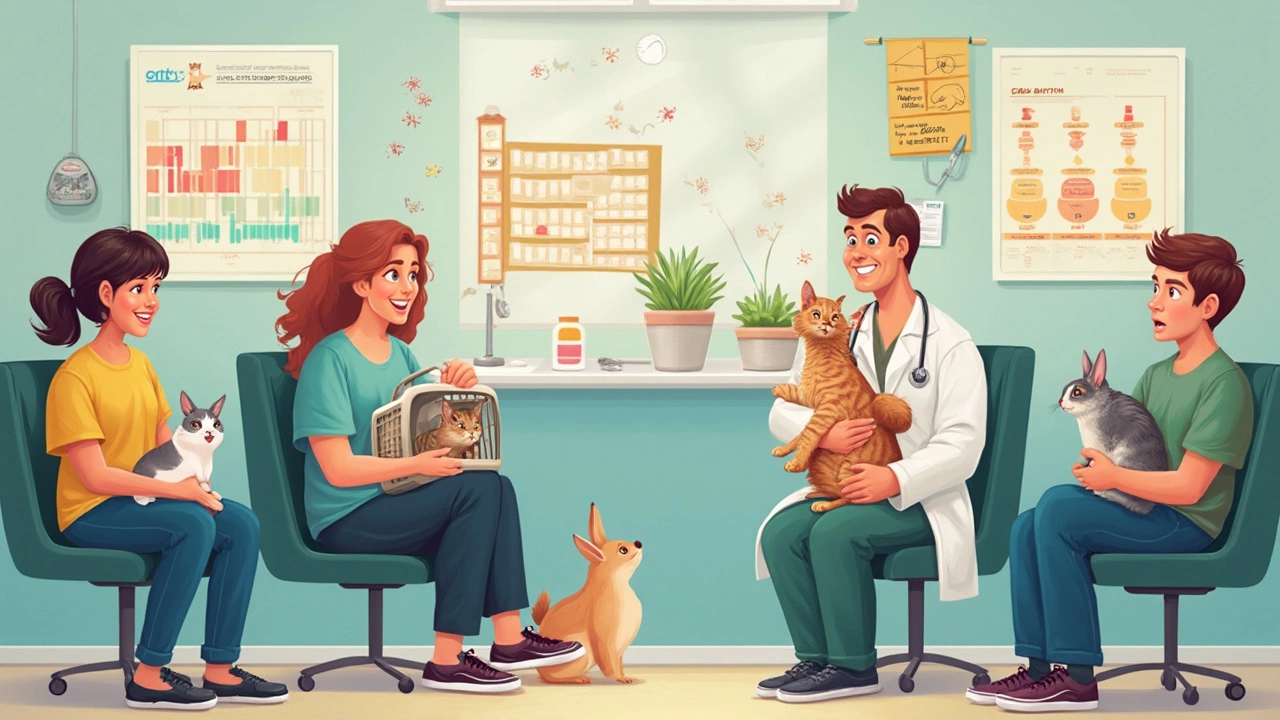Think your cat or dog is totally safe just because they never set paw outside? That’s a common belief, but here’s the kicker—being indoors doesn’t make them immune to everything. Germs, viruses, and even a tiny flea can hitch a ride on your shoes, groceries, or other pets. I used to think Darcy, our indoor cat, was safe until she got sick from something I brought home on my jacket. Not fun, and the vet bills were even less fun.
Vaccines stop a lot of scary stuff before it starts. And it’s not just about protecting your own pet—some illnesses pass to other animals or even to people. Nobody wants a nasty surprise because they skipped a simple shot. I know, getting pets to the vet can be a hassle—mine acts like I’m dragging her to prison—but skipping those visits can come back to bite you, literally and financially.
- Why Indoor Pets Aren’t as Protected as You Think
- How Diseases Sneak Inside: Surprising Risks
- Core vs. Optional Vaccines: What Does My Pet Really Need?
- What Happens If You Skip Vaccines?
- Easy Tips for Stress-Free Vet Visits
Why Indoor Pets Aren’t as Protected as You Think
It’s easy to assume our indoor cats and dogs are safe by default—there’s no roaming in the park or sniffing around in bushes, so what could go wrong? Actually, plenty. According to the American Veterinary Medical Association, indoor pets are still at risk for diseases like rabies, feline leukemia, and parvovirus. The risk drops, sure, but it doesn’t disappear.
One big problem: diseases don’t need your pet to go out; sometimes, they come to your pet. Fleas, ticks, and even some viruses are happy to hitch a ride into your home with you, other humans, or visiting animals. If you have guests with pets, all bets are off. A study from 2022 found that about 15% of indoor cats tested positive for exposure to at least one contagious disease, even though they never leave the apartment.
Take rabies, for example. In the U.S., all cats are legally required to be vaccinated, indoor or not, because close to 250 domestic pets a year still catch rabies (most from bats sneaking indoors!). An unvaccinated indoor pet can also spread illness to babies, seniors, or anyone with a weak immune system.
Here’s a quick look at some common risks for indoor pets:
- Uninvited creatures (bugs, mice, bats) carrying bad stuff
- Owners tracking in germs on shoes or clothes
- Shared air in apartment buildings (think sneezes from animals next door)
- Trips to the groomer or vet (where sick pets hang out too)
- Other pets in the house going outdoors and bringing home unwanted guests
Check out some facts comparing indoor and outdoor pet exposure:
| Disease | Chance (%) Indoor | Chance (%) Outdoor | How it Enters Home |
|---|---|---|---|
| Rabies | 0.2 | 2.1 | Bats, rodents, visiting pets |
| Feline Leukemia | 1-3 | 10-15 | Contact with infected pet, items |
| Parvovirus (Dogs) | 0.8 | 12 | Soil, contaminated shoes |
| Fleas/Ticks | 5 | 24 | Humans, other pets, open windows |
So while the odds are lower, they’re not zero. That’s why skipping out on indoor pet vaccines isn’t worth the risk—especially when prevention is a lot easier (and cheaper) than dealing with a sick pet.
How Diseases Sneak Inside: Surprising Risks
It’s wild how easy it is for those invisible germs to get through your front door, even if your pet has never been outside. Most folks are shocked when they find out how many ways illnesses find a way in. The truth? You are a big part of the problem (I was too, no judgment!). We bring in a lot more than just groceries when we come home.
Let’s break down some common ways indoor pets come in contact with stuff that can make them sick:
- indoor pet vaccines matter because viruses like parvovirus and panleukopenia can live for months on surfaces. You can carry them in on your shoes, bags, or even your hands without knowing.
- Open windows and screen doors aren’t really protective barriers. Mosquitoes slip through and spread heartworm. Even a tiny crack is enough for these guys.
- Friends and family? They might bring something in on their clothes or shoes, especially if they’ve been around other animals or farms. My sister almost gave Darcy a case of ringworm once—just from petting some kittens at a shelter before visiting us.
- Other pets in the house, like a dog that goes out for walks, can drag all kinds of bugs, fleas, or viruses right into your living room.
- Wildlife (yep, even in apartments). Mice, bats, or other critters can sneak in through vents or tiny holes, and they often carry diseases like rabies.
Here’s a quick look at just a few ways those nasty bugs can show up where you live:
| How it Gets In | Common Diseases | How Often? |
|---|---|---|
| Contaminated shoes or hands | Parvovirus, Panleukopenia | Daily risk, especially after parks or pet stores |
| Mosquito entry | Heartworm | All summer, even with screens |
| New people or visiting pets | Feline herpesvirus, ringworm | Every visit |
| Wild animals in vents/attics | Rabies, Leptospirosis | Random, but happens often in suburban and rural homes |
This isn’t to freak you out—it’s just what happens. Imagine skipping vaccinations and your cat ends up getting sick from a friend’s jacket. It’s way more common than you might think. So, even inside, your pets need protection from all the sneaky ways diseases try to get to them.

Core vs. Optional Vaccines: What Does My Pet Really Need?
If you’ve ever felt totally lost looking at those long vaccine names on your vet’s reminder card, you’re not alone. So here’s the real talk: not all shots are created equal. Some vaccines are called “core.” They’re the must-haves for every dog and cat, even if they never see the light of day outside your window. Others are “non-core” or optional, and those depend more on your pet’s lifestyle, where you live, and what your vet recommends.
Here’s what indoor pet vaccines usually come down to:
- For Cats (Core): Rabies, FVRCP (stands for Feline Viral Rhinotracheitis, Calicivirus, Panleukopenia—don’t worry, your vet just calls it the combo shot). These protect against nasty viruses that can spread through sneezes, shared bowls, or a random bat that slips through a window. Rabies isn’t just an outdoor risk—most states legally require it no matter what.
- For Dogs (Core): Rabies, Distemper, Parvovirus, and Adenovirus (often bundled in the DHPP shot). These are real danger zones, even if your pup never sniffs another dog's behind.
What about the optional (non-core) ones? Here’s where you use some brainpower:
- For Cats: FeLV (Feline Leukemia) is worth discussing for cats who might have even a small chance of sneaking outside or living with cats whose status isn’t known.
- For Dogs: Bordetella (for kennel cough), Leptospirosis, and Lyme are only needed if your dog is exposed to boarding, dog parks, or you live in certain areas.
Rule of thumb? Ask your vet, but don’t fall into the trap of thinking, “My pet’s indoors, they don’t need anything.” Core vaccines aren’t optional. They’re your backup plan in case something slips through the cracks—which, if you wear shoes or invite friends over, is totally possible.
What Happens If You Skip Vaccines?
Skipping vaccines for indoor pets might sound harmless at first, but the risks sneak up fast. Some diseases are so contagious they just need a tiny gap—an open door or a visit from a friend’s cat—to get inside. And while you might think your home is sealed tight, viruses and bacteria are pretty crafty. Here’s what leaving out those shots can really mean for your pet:
- Indoor pet vaccines like rabies or distemper protect your pet from nasty illnesses that can be fatal or require expensive treatments.
- Even strictly indoor cats get sick. One well-known study found that 15% of cats who developed feline leukemia (FeLV) had never been outdoors.
- Legal trouble is a thing, too. In most places, skipping rabies shots breaks the law—even if your pet never leaves your living room.
If your pet gets sick, it doesn’t just hit your wallet; it hits your family, too. Many diseases, such as rabies and ringworm, can spread from pets to humans. That means you’re gambling with your own health and your kids’, too.
Check out how much treatment for preventable diseases can cost versus a vaccine:
| Disease | Average Treatment Cost | Vaccine Cost |
|---|---|---|
| Rabies | $1,000+ (plus quarantine fees) | $15-25 |
| Distemper (dogs) | $800+ | $20-30 |
| Feline Leukemia | $600+ (supportive care only) | $25-40 |
Another thing—boarding or grooming places usually require proof of vaccination. If you need to leave your pet in a pinch, you may be out of luck and scrambling for a last-minute vet trip.
Bottom line? The cost and hassle of regular vaccines is nothing compared to what happens if your pet catches something nasty. Skipping them just isn’t worth it.

Easy Tips for Stress-Free Vet Visits
Going to the vet with your pet doesn’t have to be a battle every single time. I’ve had my share of wrestling matches just getting a stubborn cat into a carrier, so I’ve picked up some tricks that really work. A bit of planning makes a huge difference for everyone—especially your pet.
First, get your pet used to their carrier or crate ahead of time. Don’t just pull it out right before the visit. Leave it out for a few days with treats or a favorite blanket inside. This helps your pet see the carrier as a safe space instead of a trap.
Try short car rides before the actual vet trip so the car feel becomes less stressful. For cats, draping a towel over the carrier helps block scary sights and sounds. Play your pet’s favorite music or use a calming pheromone spray (like Feliway for cats or Adaptil for dogs) in the car and on a bandana or blanket.
If your pet hates being handled, practice gentle exams at home. Touch their paws, ears, and mouth for a few seconds each day, followed by a treat and praise. It makes the real checkup less scary because they know what to expect.
Got a pet who freaks out at new places or people? Book the first appointment of the day or ask about "quiet hours." Some clinics now set aside low-rush times that are way calmer for nervous animals. You can also bring a favorite toy or treat for comfort—and don’t forget your pet’s medical records, especially shot info, so nothing gets missed.
Finally, stay calm yourself. Pets pick up on our nerves fast. If you act chill, your pet is a little more likely to relax too. Over time, these simple steps add up, making every indoor pet vaccines visit way easier for both of you.
